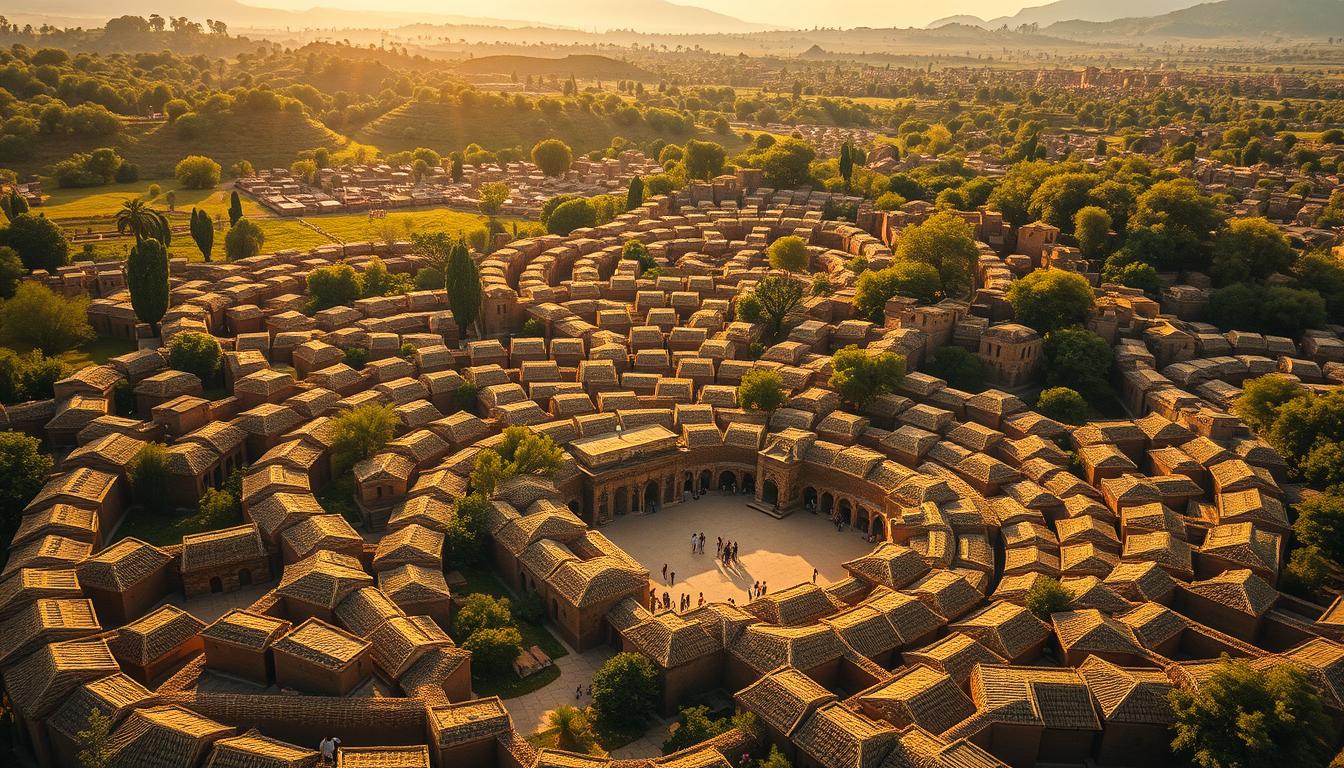Fractals show how nature repeats patterns, deeply connecting with sustainable farming. These patterns are not just for math lovers. They are key in ancient farming techniques. By looking at fractals, we learn how traditional farmers worked with nature to boost crops and keep the earth healthy. This part talks about the importance of fractals in old farming ways, showing how they help in keeping farming sustainable all over the world.
The Concept of Fractals
Fractals are where math meets nature in a beautiful dance. They help us see how common they are around us, especially in nature. These patterns show there’s order in chaos, with their complex shapes outshining simple geometric forms. Benoit Mandelbrot was the genius who introduced fractals to us all.
Definition and Origins
Fractals are structures that repeat themselves at different sizes. They’re fascinating in math and mirror real-life wonders in nature. The word “fractal” comes from “fraʹctus,” a Latin term meaning broken. Thanks to Mandelbrot’s work in 1982, we understand how fractals shape everything from coastlines to clouds.
Fractals in Nature
Nature is rich with fractals, from tree branches to snowflake designs. These patterns are not just stunning; they’re smart, showing complexity from simple rules. They help nature work better, teaching us about efficiency in farming and managing resources. Fractals in nature make us admire the natural order in the world.

Understanding Indigenous Farming Techniques
Indigenous farming methods are rooted in centuries of knowledge. They blend agricultural production with care for the environment. These practices boost crop resilience and biodiversity, key to their farming culture.
Traditional Approaches to Agriculture
These farming methods are tailored to fit the landscape. Here are some examples:
- Polyculture: Growing different crops together to improve soil and reduce pests.
- Rotation grazing: Moving animals to keep land healthy and avoid overuse.
- Agroforestry: Mixing trees with crops to support diverse species and provide shelter.
This not only helps the land but also keeps community heritage alive.
Geographical Varieties
Farming practices vary by region, each shaped by its unique nature and history. Some examples include:
- Andean farmers build raised beds for potatoes, adapting to varied climates.
- Wetland rice paddies in Southeast Asia use water management to boost yields and care for the environment.
- The Three Sisters method in North America uses corn, beans, and squash to enrich the soil and support each other.
These methods show how indigenous peoples tailor farming to fit their environment. This ensures their practices are sustainable for the future.
The Influence of Fractals on Indigenous Agricultural Techniques
Fractals impact deeply how indigenous methods in farming work. These methods are smart. They use what nature shows to manage resources well and farm sustainably. By looking at fractals, native farmers plan crop placements that act like nature itself. This way, farming gets a lot of wins.
Here’s why this matters:
- Promoting biodiversity through diversified planting patterns.
- Encouraging sustainable land-use practices that are tailored to local climates.
- Improving yields by utilizing ecological design principles that align with natural processes.
Digging into fractals in indigenous agricultural techniques ties us closer to the earth. It grows ways of farming that can adjust and stay strong. It’s about working together with nature, not against it. This mix of old wisdom and new science is key for harmony between farming and the environment.
Fractal Patterns in Agricultural Design
Fractal patterns are seen in nature and are important for farming design. These patterns are found in ecosystems and bring benefits to farms. By copying these patterns, farms can become more resilient and use resources better.
Examples of Fractal Patterns in Nature
Here are some fractal patterns we see in nature:
- Branching systems of rivers that create networks for efficient water distribution.
- Tree canopies that maximize sunlight capture and support biodiversity.
- Leaf arrangements that optimize space and light for photosynthesis.
Application in Crop Layouts
Using fractal designs in farm layouts makes space and resources more efficient. Some techniques are:
- Permaculture designs that mimic natural ecosystems, fostering biodiversity and reducing pests.
- Agroforestry systems, where trees and crops grow together, enhancing soil health and productivity.
- Spatial arrangements that facilitate irrigation and reduce dependency on water resources.
Self-Similarity in Farming Structures
Self-similarity is key in understanding farming patterns. It shows up across different sizes and shapes. This idea comes from fractal geometry. It shows how crops and farming methods can show similar traits. This helps make farms efficient and balanced ecosystems.
By using self-similar designs, farms become tougher and greener.
Concept of Self-Similarity Explored
Self-similarity means designs repeat at various levels. In farming, this could be how crops are arranged, how water is distributed, or how soil is cared for. These patterns make the best use of land and boost productivity. They let farmers use successful methods on different scales. This makes sure resources are used well.
Benefits to Resource Management
Using self-similarity in farming has big benefits. These include:
- Improved water use through smart layout.
- Better soil health by copying nature.
- More crops by using space and resources wisely.
Fractal geometry principles help farmers build farms that do well and last. They fit into the environment while keeping crop yields high.
Energy Efficiency in Indigenous Practices
Indigenous methods are smart about energy use in farming. They use the natural flow of ecosystems. This helps the environment and people living there.
By using old wisdom, farmers make more food and save resources.
Fractals and Natural Energy Flow
Fractals in nature help guide native farming ways. They make it easier to understand how energy moves. Using these patterns can improve the conditions for crops.
These ideas help plants get enough sun and water. They also cut down on waste.
Optimization of Resources
Crop rotation and smart watering systems use fractals too. They help use resources better. For instance, following the land’s natural shape helps with water flow.
Success Stories of Fractal Applications
Fractal applications in agriculture show how indigenous cultures use natural patterns in their farming. These stories highlight the benefits of fractal designs on farm efficiency and eco-friendliness. They illustrate its use in different cultural practices.
Case Studies from Various Cultures
- Andean farming communities use terraced fields with fractal principles. This helps save water and increases farmable land, which is crucial in the mountains.
- In Japan, fractal patterns in rice paddies help manage water and rotate crops. This improves the yield and the health of the soil.
- African agroforestry systems arrange trees and crops in fractal patterns. This boosts biodiversity and supports sustainable food production.
Insights from Modern Adaptations
Today, agricultural researchers are seeing the value in these old methods. They study these examples to find new ways to use fractal applications in farming. These modern methods boost farm efficiency and stress the role of cultural practices. They help with food security and keeping the environment healthy.
Critical Analysis of Fractal Influence
Studying fractal influence in farming needs a deep look at its pros and cons. Knowing the good sides of fractals can make farming better for nature and more efficient. But, it’s important to see the difficulties that could come up to not oversimplify complex farm systems.
Benefits and Drawbacks
Fractal influence in farming brings many benefits, such as:
- Improved resource management through optimized layouts.
- Alignment with natural ecosystems, promoting biodiversity.
- Enhanced yield productivity by leveraging self-similar structures.
However, there are downsides to think about:
- Risk of misapplying fractal patterns to unsuitable environments.
- Oversimplification of complex variables involved in agriculture.
- Challenges in adopting fractal principles in traditional practices.
Challenges in Implementation
Using fractal influence in farming faces several challenges. Important points include:
- Training and educating farmers on fractal concepts.
- Assessing local environmental conditions to ensure compatibility.
- Balancing traditional knowledge with modern techniques for sustainable practices.
Overcoming these challenges needs a good plan and continuous analysis. This helps adjust fractal principles well in different farming situations.
Fractals and Soil Health
Studying fractal geometry helps us understand soil structure better. This matters a lot for soil health. By looking at soil’s complex patterns, experts can tell how these patterns impact soil’s life-supporting abilities.
Relation Between Fractal Geometry and Soil Structure
Fractal geometry is a tool for describing soil structure. Soils show similar patterns, big and small, which tells us about their porosity and how well they hold together. These factors are vital for creating a thriving environment for plants and animals. Knowing the fractal dimensions helps us keep soil healthy or make it better.
Impact on Soil Nutrient Availability
The way soil is structured, guided by fractal geometry, impacts nutrient availability. Well-structured soils improve water flow and air, which helps microbes break down nutrients for plants. Soils with good structure keep nutrients better than those that are compact or poorly organized. This shows why using fractal ideas in managing soil is key to boosting its health.
Integration of Traditional Wisdom with Modern Science
Merging old wisdom with new farming methods is key. It makes farming better and helps it last longer. By using knowledge from the past, today’s farmers can solve big problems.
The Role of Indigenous Knowledge
Old knowledge is key to keeping farms working well with nature. It teaches us about rotating crops, caring for soil, and fighting pests, all learned over many years. Using these old ways now can make farming better for everyone.
Collaborations with Agricultural Researchers
When local farmers and scientists work together, great things happen. They mix traditional practices with scientific research to farm in smarter ways. This teamwork leads to more crops and helps protect our planet for the future.
Future Directions for Research and Practice
The way we do farming needs to change towards being more caring for our planet. We should use sustainability as our guide for new research in farming. This means using ideas from fractals to come up with new ways that help with resource use and fighting climate change.
This kind of thinking helps both nature and farming flourish together. It makes farming strong enough to face big challenges.
Importance of Sustainability
Sustainability is a must for farming’s future, not just a passing phase. It lets farmers keep producing food without harming our Earth. Research should look into fractals in farming to improve water use, soil, and growing different plants and animals together.
Doing this helps make sure farming can last a long time.
Potential Innovations in Agriculture
As we look ahead, farming research should include new tech but still hold onto sustainability. We could see new methods like:
- Using precise farming methods with fractal data for better crop care.
- Creating tough crop types by studying patterns in traditional farming.
- Putting in watering systems that use water wisely when it’s dry.
These new ideas could help build farming methods that last and are ready for future challenges.
Celebrating Indigenous Knowledge Systems
Indigenous knowledge systems are like a rich tapestry. They don’t just keep agriculture going; they also keep cultures alive. These systems teach us how to live sustainably and cherish biodiversity. They show how people and nature can work together beautifully. By valuing indigenous knowledge, we show respect for different ways of farming. It also tells us how important it is to keep these traditions going.
Preservation of Cultural Heritage
Cultural heritage and indigenous knowledge are closely linked. It’s more than just old stories; it includes farming methods passed down through years. These methods help in growing food in a sustainable way. They’re key to how we all get our food. By keeping these traditions alive, we make sure this crucial knowledge stays around. This helps everyone, now and in the future.
Lessons for Global Agriculture
Indigenous knowledge teaches big lessons about farming the world over, especially about keeping things going long term. Many native groups know how to use what they have wisely. This helps a lot in not wasting resources and getting good crops. We can learn from these ways to farm smarter today. By using indigenous knowledge, farming can get better and be more fair for everyone.
Conclusion
We’ve seen that fractals in old farming methods show a strong bond with nature’s designs and farming success. This article pointed out how these shapes are found in many traditional farming ways. They play a big part in creating lasting agriculture.
They help with managing resources better and build a strong tie between culture and the earth. This is based on the knowledge from long ago.
Old farming ways show the worth of mixing past wisdom with today’s science. Seeing fractals in these methods highlights how important it is to take care of our environment. It also shows how new, sustainable farming methods can be created.
This can help lead the way to farming that respects nature and keeps cultural stories alive. In the end, learning about fractals in old farming shows us how to help communities and make rules for better sustainability.
By using what we learn, we can aim for a future where farming feeds us all. Yet, it also takes care of our planet and keeps various cultures alive.



